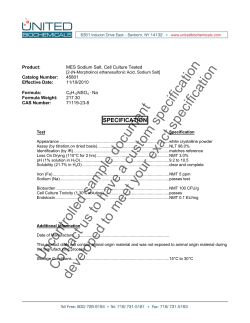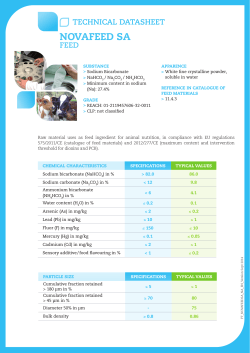
SODIUM HYPOCHLORITE STABILITY
SODIUM HYPOCHLORITE STABILITY Sodium hypochlorite is an excellent sanitiser that is commonly used in industries world-wide. Its’ popularity is derived from the fact that while it has a proven wide-spectrum of activity, it deodorises, it is nonpoisonous in low concentrations and it breaks down to give harmless naturally occurring products (salt, water, oxygen). While sodium hypochlorite has many positive aspects it is a reactive compound that degrades over time. The decomposition reaction is as follows: 2 NaOCl Sodium Hypochlorite → 2NaCl Sodium Chloride + O2 Oxygen The stability and shelf life of commercially available sodium hypochlorite is adversely affected by the following factors: • Heat - For example: the shelf life of 12.5% sodium hypochlorite is decreased by a factor of approximately three times when the storage temperature is raised from 25°C to 35°C. • Low pH - Lowering the pH will decrease the sodium hypochlorite in solution, and can liberate free chlorine. • Sunlight - Exposure to UV light degrades sodium hypochlorite. • Contamination - The presence of certain metals in solution (eg nickel) will promote degradation. Some metals (e.g. iron) are not particularly detrimental to the stability. Standards Australia has recognised the stability issues associated with sodium hypochlorite. In AS10871991 (“Sodium hypochlorite solutions for use in the dairying industry”, which is the most relevant standard available) the standard states: 1) “When solutions of sodium hypochlorite are allowed to stand, the amount of available chlorine slowly diminishes” and 2) “Two consequences of this decomposition are that first, the chemical properties specified must be determined, and the product delivered to the customer without undue delay; and second, the concentration of the sanitising solution must be checked before use and, if necessary, allowance made when sanitising if the solution is under-strength.” AS1087-1991 sets a few minimum requirements for stability of 12.5% sodium hypochlorite: • The initial product must have a level of 125– 135 g/L available chlorine. • After 28 days at room temperature the solution must have a minimum of 100g/L available chlorine. • The product must satisfy a stability test: Heat at 70°C for 4 hours and still have a minimum of 96g/L available chlorine. The degradation of sodium hypochlorite is proportional to its concentration. Stronger concentrations degrade faster than more dilute ones. Graphs of 10% sodium hypochlorite degradation and how it relates to storage temperature are shown below: THE STABILITY OF SODIUM HYPOCHLORITE 10% Note: Data is for 10% sodium hypochlorite Health and safety regulations require us to label products with the level of hazardous ingredients in the product that consumers may come into contact with. 135g/L is the maximum level of available chlorine in our product (on day one of manufacture) and thus we label our product as containing this level. The Australian Standard also states that the nominal concentration of the solution ie 50g/L, 100g/L or 125g/L available chlorine should be shown on the label. Combining these two requirements, we generally label our products with information like “12.5% Sodium Hypochlorite” which is a statement of the nominal concentration, followed by “Active Constituents: 135g/L available chlorine” to satisfy the criteria. Final Notes on Sodium Hypochlorite Stability: • Sodium hypochlorite is an excellent broad-spectrum sanitiser that is accepted throughout industries worldwide. • Sodium hypochlorite does degrade over time. The degradation products are naturally occurring compounds. • Sodium hypochlorite stability is adversely affected by increases in storage temperature, low pH, exposure to sunlight and some metals in solution.
© Copyright 2025











